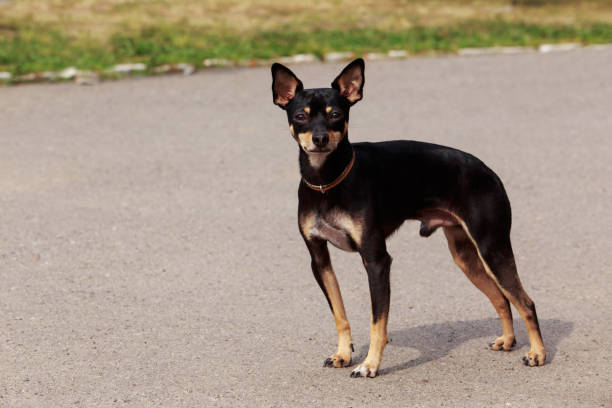English Toy Terrier

Breed History:
The English Toy Terrier, also known as the English Toy Terrier (Black & Tan), is one of the oldest toy breeds native to Britain. It descends directly from the old Black and Tan Terrier, which was popular during the 19th century as a skilled ratter and companion. These small yet agile dogs were frequently used in rat pits—entertainment arenas where dogs showcased their speed and efficiency in killing rats.
As rat-baiting declined, the breed transitioned into a fashionable lap dog, prized for its elegant appearance and loyal disposition. The breed was refined for a more delicate frame and polished demeanour, becoming a favourite of Victorian society. Despite its long history, the English Toy Terrier is now a relatively rare breed, especially outside the UK.
|
Gender |
Height |
Weight |
|
Male |
25–30 cm |
2.7–3.6 kg |
|
Female |
25–30 cm |
2.7–3.6 kg |
Size – Small
Life Expectancy: 12–15 years

Breed Appearance:
The English Toy Terrier is a small, fine-boned, and graceful breed with a distinctive black and tan coat. Its sleek, short fur lies close to the skin and is easy to maintain. The breed has a wedge-shaped head with a fine muzzle and large, erect, candle-flame-shaped ears that contribute to its alert expression.
Its almond-shaped eyes are dark and sparkling, and its tail is carried low and tapers to a point. The English Toy Terrier has a compact and athletic build, reflecting its history as a working terrier despite its elegant appearance.
Breed Type – Companion/Watchdog:
Though originally used for vermin control, the English Toy Terrier is now a charming and devoted companion. It is affectionate and forms strong bonds with its family, thriving on attention and companionship. The breed is alert and observant, making it a reliable little watchdog.
Despite its small size, it has a confident, spirited personality and can be somewhat reserved with strangers. With proper socialisation, it gets along well with older children and other pets but may show dominance or aloofness toward unfamiliar dogs.

Training:
The English Toy Terrier is intelligent and eager to please, making it generally easy to train. It responds well to positive reinforcement, especially with treats and praise. Early socialisation and exposure to different environments are important to build their confidence and prevent excessive shyness or barking.
Its terrier background means it can be independent at times, so training should be consistent, engaging, and not overly repetitive. Harsh methods should be avoided, as this breed responds best to gentle, reward-based techniques.
Health & Care:
The English Toy Terrier is a hardy and long-lived breed with relatively few genetic issues. However, as with many toy breeds, it can be prone to:
-
Patellar luxation (dislocated kneecap)
-
Dental problems due to a small jaw size
-
Legg-Calvé-Perthes disease (hip joint issue)
Routine vet check-ups, proper dental hygiene, and maintaining a healthy weight can help prevent or manage these conditions. The breed's low body fat and fine coat make it more sensitive to cold, so extra care is needed in colder climates.

Living Conditions:
This breed is highly adaptable and well-suited to both apartment living and houses with secure yards. The English Toy Terrier is clean, quiet, and relatively inactive indoors, but still enjoys bursts of play and exploration. It should live indoors as part of the family and is not suited to living outside.
While it enjoys cuddling and lounging, it still retains moderate energy levels and needs regular walks and interaction to stay mentally and physically satisfied.
Exercise:
Though small, the English Toy Terrier is lively and enjoys regular walks, games of fetch, and short play sessions. About 30–45 minutes of daily exercise is sufficient, along with mental enrichment through training or toys.
Due to its quick reflexes and prey drive, it should always be walked on a leash or exercised in secure areas. It enjoys agility and other small dog sports, which can also help burn off excess energy.
Grooming:
Grooming the English Toy Terrier is simple and low-maintenance. Its short, glossy coat only requires a weekly brushing with a soft-bristle brush or grooming mitt to remove loose hairs and keep the coat looking its best.
Bathing should be occasional, typically when dirty. Regular dental care is essential to prevent periodontal issues. Check and clean ears weekly, and trim nails regularly to prevent overgrowth and cracking.

Advantages:
-
Small, elegant, and low-shedding—ideal for apartment living
-
Loyal, affectionate, and good with attentive families
-
Intelligent and easy to train with gentle guidance
-
Low grooming needs and clean habits
-
Alert and makes a good little watchdog
-
Long lifespan with relatively few serious health issues
Disadvantages:
-
Prone to barking if not properly trained and socialised
-
May be shy or aloof with strangers or other dogs
-
Fragile build—not ideal for rough play or very young children
-
Needs consistent dental care due to a small mouth size
-
Sensitive to cold weather due to a thin coat
-
Can be stubborn without firm, positive training

